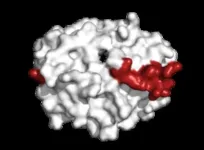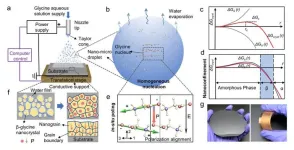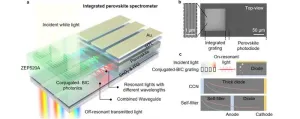(Press-News.org) CHAPEL HILL, N.C. – Platelets, or thrombocytes, are specialized cellular fragments that form blood clots when we get scrapes and traumatic injuries. Viral infections, autoimmune disease, and other conditions can cause platelet levels to drop throughout the body, termed thrombocytopenia.
After a robust clinical and research collaboration, Stephan Moll, MD, and Jacquelyn Baskin-Miller, MD, both in the UNC School of Medicine, have linked adenovirus infection with a rare blood clotting disorder. This is the first time that the common respiratory virus, which causes mild cold-and flu-like symptoms, has been reported to be associated with blood clots and severe thrombocytopenia.
“This adenovirus-associated disorder is now one of four recognized anti-PF4 disorders,” said Moll, professor of medicine in the Department of Medicine’s Division of Hematology. “We hope that our findings will lead to earlier diagnosis, appropriate and optimized treatment, and better outcomes in patients who develop this life-threatening disorder.”
Their new observation, which was published in the New England Journal of Medicine, sheds new light on the virus and its role in causing an anti-platelet factor 4 disorder. Additionally, the discovery opens a whole new door for research, as many questions remain as to how and why this condition occurs – and who is most likely to develop the disorder.
HIT, VITT, and “Spontaneous HIT”
Antibodies are large Y-shaped proteins that can stick to the surface of bacteria and other “foreign” substances, flagging them for destruction by the immune system or neutralizing the threat directly.
In anti-PF4 disorders, the person’s immune system makes antibodies against platelet factor-4 (PF4), a protein that is released by platelets. When an antibody forms against PF4 and binds to it, this can trigger the activation and rapid removal of platelets in the bloodstream, leading to blood clotting and low platelets, respectively.
Sometimes, the formation of anti-PF4 antibodies is triggered by a patient’s exposure to heparin, called heparin-induced thrombocytopenia (HIT), and sometimes it occurs as an autoimmune condition without heparin exposure, which is referred to as “spontaneous HIT.”
In the last three years, thrombocytopenia has been shown to rarely occur after injection with COVID-19 vaccines that are made with inactivated pieces of an adeno–viral vector. These vaccines are different than the ones made in the United States, such as those by Moderna and Pfizer. The condition is referred to as vaccine-induced immune thrombotic thrombocytopenia (VITT).
The Road to Discovery
The road to the discovery started when a 5-year-old boy who had been diagnosed as an outpatient with adeno virus infection had to be admitted to the hospital with an aggressive blood clot forming in his brain (called cerebral sinus vein thrombosis) and severe thrombocytopenia. Doctors determined that he hadn’t been exposed to heparin or the adeno-vector COVID-19 vaccination, the classical triggers for HIT and VITT.
“The intensive care unit physicians, the neuro-intensivist, and hematology group were working around the clock to determine next steps in the care for this young boy,” said Baskin-Miller. “He wasn’t responding to therapy and was progressing quickly. We had questioned whether it could have been linked to his adenovirus considering the vaccine data, but there was nothing in the literature at that time to suggest it."
The collaborative clinical effort to help the patient expanded: Baskin-Miller reached out to Moll, who is an expert in thrombosis and has various connections throughout the field. To Moll, it looked like the pediatric patient could have “spontaneous HIT”. They then tested for the HIT platelet activating antibody, which came back positive.
Collaboration is Key
Moll reached out to, Theodore E. Warkentin, MD, a professor of pathology and molecular medicine at McMaster University in Hamilton, Ontario, who has been researching anti-PF4 disorders for three decades, to hear if he was aware of an association between adenoviral infection and spontaneous HIT. Warkentin, who is one of the premier international anti-PF-4 disorders researcher, wasn’t aware of the condition.
Around the same time, Moll received a phone call from Alison L. Raybould, MD, a hematologist-oncologist in Richmond, Virginia, a previous trainee from UNC. She was seeing a patient who had multiple blood clots, a stroke and heart attack, arm and leg deep-vein thromboses (DVT), and severe thrombocytopenia.
The patient had not been exposed to heparin or vaccines. However, this patient’s severe illness had also started with viral symptoms of cough and fever, and she had tested positive for adenoviral infection. Testing for an anti-PF4 antibody also turned out to be positive.
To help clarify the diagnoses of the two patients, Warkentin immediately offered to further test the patients’ blood and samples were directly to his laboratory in the Hamilton General Hospital for further study. They confirmed that the antibodies were targeting platelet factor 4, much like the HIT antibodies.
Surprisingly, the antibody resembled that of the VITT and bound to PF4 in the same region as VITT antibodies do. They concluded that both the patients had “spontaneous HIT” or a VITT-like disorder, associated with an adenovirus infection.
More Questions
Following such a groundbreaking conclusion, Moll and colleagues are now left with many questions about the prevalence of the new anti-PF4 disorder, whether the condition can be caused by other viruses, and why this condition doesn’t occur with every infection with adenovirus.
They also wonder what preventative or treatment measures can be made to help patients who develop the new, potentially deadly anti-PF4 disorder.
“How common is the disorder?” asked Moll. “What degree of thrombocytopenia raises the threshold to test for anti-PF4 antibodies? And then finally, how do we best treat these patients to optimize the chance that they will survive such a potentially deadly disease?”
END
Common cold virus linked to potentially fatal blood clotting disorder
2023-08-10
ELSE PRESS RELEASES FROM THIS DATE:
Education program tackles race-based cancer health disparities
2023-08-10
HOUSTON – (Aug. 10, 2023) Rice University chemist Carolyn Nichol has won a competitive Science Education Partnership Award (SEPA) from the National Institutes of Health to address race-based cancer health disparities by increasing underrepresented minority student populations’ engagement and participation in biosciences education.
The 5-year, $1,038,544 award will support Nichol’s Cancer Health Activism Network for Greater Equity (CHANGE) project in bringing together cutting-edge cancer research with insight on race-based healthcare disparities from the social sciences in a series of transformative high school biology lessons aligned with both ...
Font size can 'nudge' customers toward healthier food choices
2023-08-10
PULLMAN, Wash. -- Restaurants can persuade patrons to choose healthier foods by adjusting the font size of numbers attached to nutritional information on menus, according to a study headed by a Washington State University researcher.
Lead researcher Ruiying Cai, an assistant professor in the WSU School of Hospitality Business Management, said U.S. restaurants with more than 20 locations are already required to show the calorie content of food on their menus. By representing these values incongruously — using physically larger numbers on the page when they’re attached to ...
Researchers unlock mystery of cartilage regeneration in lizards
2023-08-10
A team of researchers from the Keck School of Medicine of USC have published the first detailed description of the interplay between two cell types that allow lizards to regenerate their tails. This research, funded by the National Institutes of Health and published on August 10 in Nature Communications, focused on lizards’ unusual ability to rebuild cartilage, which replaces bone as the main structural tissue in regenerated tails after tail loss.
The discovery could provide insight for researchers studying how to rebuild cartilage damaged by osteoarthritis in humans, a degenerative and debilitating disease that affects about 32.5 million adults ...
Space weather and satellite security: Graz University of Technology and University of Graz supply new forecasting service for the ESA's Space Safety Programme
2023-08-10
After a successful test phase, the Satellite Orbit DecAy (SODA) service, which was jointly developed by TU Graz and the University of Graz, officially became part of the ESA’s Space Safety Programme in mid-July. SODA provides accurate forecasts of the effects of solar storms on low Earth orbiting satellites. This makes TU Graz only the third Austrian institution contributing to this ESA programme. Seibersdorf Laboratories, and the University of Graz, through the Kanzelhöhe Observatory and the Institute of Physics, ...
New high-tech microscope using AI successfully detects malaria in returning travelers
2023-08-10
Each year, more than 200 million people fall sick with malaria and more than half a million of these infections lead to death. The World Health Organization recommends parasite-based diagnosis before starting treatment for the disease caused by Plasmodium parasites. There are various diagnostic methods, including conventional light microscopy, rapid diagnostic tests and PCR.
The standard for malaria diagnosis, however, remains manual light microscopy, during which a specialist examines blood films with a microscope to confirm the presence of malaria parasites. ...
HKUST researchers pioneers technique to self-assemble high-performance biomolecular films
2023-08-10
A research team led by The Hong Kong University of Science and Technology (HKUST) has developed a novel technique to self-assemble a thin layer of amino acids with ordered orientation over a large area that demonstrates high piezoelectric strength, making the manufacturing of biocompatible and biodegradable medical microdevices, such as pacemaker and implantable biosensor, in the near future possible.
The generation of bioelectricity from the piezoelectric effect – reversible conversion between mechanical and electrical energies – has physiological significance in living systems. ...
A platform for integrated spectrometers based on solution-processable semiconductors
2023-08-10
Acquiring real-time spectral information in point-of-care diagnosis, internet-of-thing, and other lab-on-chip applications require spectrometers with hetero-integration capability and miniaturized feature. Compared to conventional semiconductors integrated by heteroepitaxy, solution-processable semiconductors provide a much-flexible integration platform due to their solution-processability, and, therefore, more suitable for the multi-material integrated system. However, solution-processable semiconductors are usually incompatible with the micro-fabrication processes, making them far from practical use in various lab-on-chip applications.
In a new paper published ...
Researchers develop novel technology to quantify protein critical to blood clot formation through breath gas analysis
2023-08-10
Immunothrombosis, or the formation of microscopic blood clots during inflammation, is a major cause of morbidity among patients with sepsis or severe COVID-19. A key enzyme in this process is thrombin. To date, no method exists for early detection of immunothrombosis in a living organism.
A team of investigators led by Ali Hafezi-Moghadam, MD, PhD, director of the Molecular Biomarkers Nano-Imaging Laboratory (MBNI) at Brigham and Women’s Hospital, a founding member of Mass General Brigham healthcare system, and an associate professor of Radiology at Harvard Medical School, developed a novel technology to diagnose immunothrombosis by measuring ...
C-Path welcomes Sanofi to its Type 1 Diabetes Consortium to help advance drug development
2023-08-10
TUCSON, Ariz., August 9, 2023 — Critical Path Institute (C-Path) announced today that Sanofi, a global leader in immunology and diabetes care, has joined its Type 1 Diabetes Consortium (T1DC). Sanofi joins T1DC as part of its commitment to push the boundaries of innovation to improve the lives of those with diabetes.
T1DC was established in 2017 with the goal to significantly advance the drug development landscape for T1D prevention and treatment. The consortium achieves this by fostering ...
How sure is sure? Incorporating human error into machine learning
2023-08-10
Researchers are developing a way to incorporate one of the most human of characteristics – uncertainty – into machine learning systems.
Human error and uncertainty are concepts that many artificial intelligence systems fail to grasp, particularly in systems where a human provides feedback to a machine learning model. Many of these systems are programmed to assume that humans are always certain and correct, but real-world decision-making includes occasional mistakes and uncertainty.
Researchers from the University of Cambridge, along with The Alan Turing Institute, Princeton, and Google DeepMind, have been attempting ...







